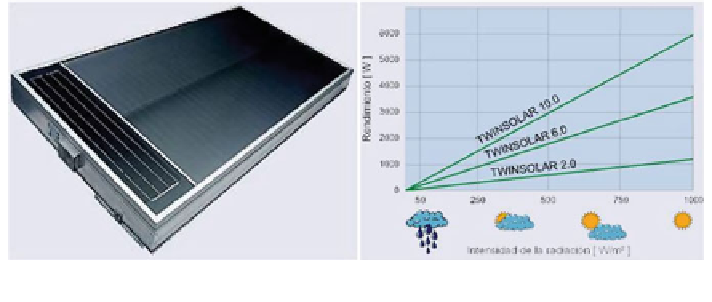Civil Engineering Reference
In-Depth Information
building in Hong Kong. The annual thermal efficiencies were found to be around
48 % for the thin-film silicon and 43 % for the crystalline silicon case, respec-
tively. In addition, the building intergraded system was able to reduce the cooling
requirements of the building substantially due to the reduced heat absorption by
walls.
For refrigerant/heat-pipe-based PV/T, Nishikawa et al. (
1993
) studied a PV/T
heat pump system using R22 as the refrigerant. When the PVs were effectively
cooled, the system could achieve higher COP than a conventional heat pump
could. Ito et al. (
1997
) worked on a similar PV/T heat pump and found that when
the condensation temperature was set at 40 C, the COP of heat pump could
achieve as high as 6.0. Further, Ito et al. (
1999
) analysed the effect of a few
physical parameters, e.g. collector area, width, length and thickness of the col-
lector plate to the system's solar efficiency and COP. Zhao et al. (
2008
,
2009
,
2010
) initiated a PV/flat-plate heat pipe with micro-channel arrays inside to pro-
duce electricity and hot air/water simultaneously, which is detailed in Fig.
11
.
Further, Qian et al. (
2008
,
2010
) invented a building integrated PV/T system using
oscillating heat pipe for the combined heat and power generation using solar
energy. This type of system was addressed in Fig.
12
.
3.2 Practical Application of the PV/T Technologies
Although the PV/T technology is in the start-up stage, some commercial products
or engineering projects related to PV/T application can still be found in practice. A
number of PV/T practical works are addressed as follows:
'GRAMMER Solar GmbH' in Germany has developed an air-based PV/T solar
collector titled 'TWINSOLAR', which is designed to preheat ventilation air in
buildings and has the absorber area of between 1.3 and 12.5 m
2
. The modules can
be assembled vertically or horizontally, on the roof or on the south, south-east or
south-west facing facades. It is observed that at maximum solar radiation of
700 W/m
2
, the air temperature rose to 40 C and nearly 70 % of the solar incident
Fig. 13
The 'TWINSOLAR' application and its performance curve (Zhang et al.
2012
)

